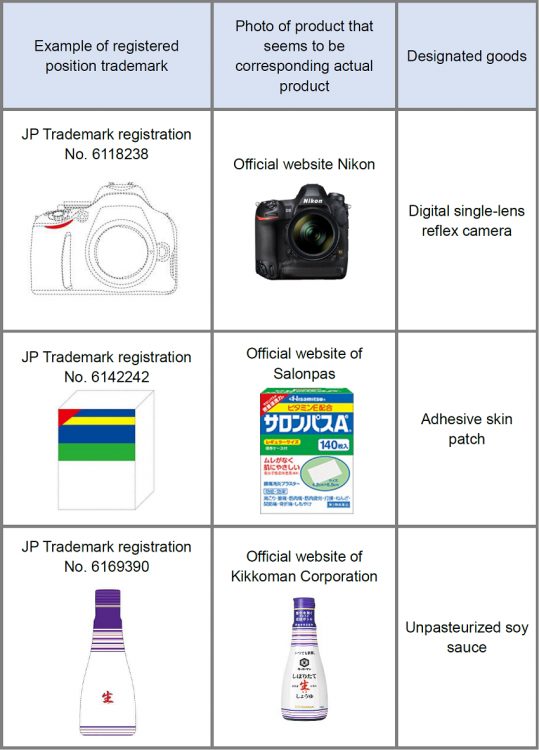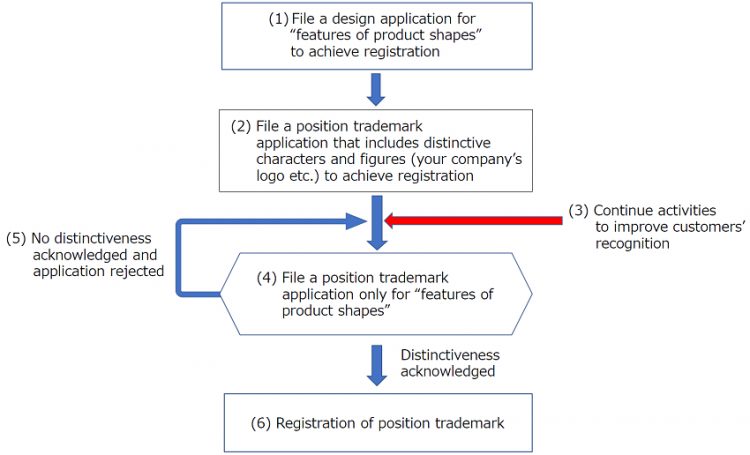2022.06.15 Trademark
Strategic use of the position trademark system in Japan can increase your company’s brand values.
1. Introduction
Regarding trademarks with a mark consisting of characters, figures, and so on placed on a particular portion of a product or packing (hereinafter “position trademark”), it is possible in Japan since April 1, 2015 to file a trademark application and have such a trademark registered. In this connection, a large number of companies have been making efforts to file applications in Japan for a part of three-dimensional shapes of a product as a “position trademark”.
Renewing trademark registrations of such a part of three-dimensional shapes and thereby achieving a nearly permanently possessable trademark right of “position trademark” enables owners to exclusively use the three-dimensional shapes in the market and to more easily attract consumers’ attention. As a result, owners can expect an increase of brand values relating to the three-dimensional shapes and advantages including a prospect of sales increase.
This newsletter introduces, for all readers’ references, some position trademarks that have been registered in Japan so far since the commencement of the position trademark system. The newsletter will also briefly describe one practical approach (proposed strategy) that can assist you in the future with achieving a trademark registration in Japan for a part of three-dimensional shapes of your product as a “position trademark”.
2. Examples of Registered Position Trademarks in Japan
The following introduces examples of actual trademarks that have been granted registration through examination or trial. Shown below, in addition to registration information of “position trademarks”, are photos of the products that seem to be the actual products corresponding to the “position trademarks” in the market.
<Examples of Trademarks Registered in Examination Stage>

<Examples of Trademarks Registered in Trial Stage>

3. Possible Proposed Strategy for Achieving Position Trademark Registration
As shown above, a relatively large number of position trademarks have been granted registration in Japan. During examination of position trademark applications, whether applied trademarks possess distinctiveness often becomes a significant issue.
In fact, recent judgements of the Japanese IP High Court determine that if a trademark filed as a “position trademark” is a part of three-dimensional shapes of a product, distinctiveness of the filed “position trademark” should be denied “unless there are special circumstances such that the three-dimensional shapes exceed a range in which the shapes are expected to be employed by products of the same type for the reasons of function or aesthetic impression” (2019 (Gyo-Ke) 10125, 2020 (Gyo-Ke) 10076, etc.)
The above-listed position trademarks “registered in trial stage” were questioned during examination whether such denial of distinctiveness would be applicable and, after numerous submissions of additional argumentation and substantiation, were finally granted registration at their trial stages.
According to the aforementioned recent judgements of the IP High Court, in order to substantiate that an applied “position trademark” possesses distinctiveness, “it should be determined by a comprehensive consideration of circumstances such as the shapes of the trademark filed as a “position trademark”, the period and area of use of the trademark, the sales volume of products bearing the trademark, the period and scale of advertisement of the trademark, and whether or not there are other products having shapes similar to those of the trademark”.
In short, it is necessary to substantiate the circumstances that a large number of consumers recognize the source of the product based only of the trademark concerning the position trademark and thus make purchases of the product.
In addition, even if third parties emerge, attempting to sell competitors’ products with shapes similar to those of the position trademark, it is recommended that the applicant of the position trademark try to eliminate the competitor’s products by warning the third parties while providing a legal basis from Unfair Competition Prevention Act, for example. Argumentation and substantiation based on histories of making such efforts in the market and achieving successful results are also acknowledged on a practical level as a way leading to prove that the applied “position trademark” possesses distinctiveness (and thus appropriate to be granted registration).
In other words, features of product shapes that seemingly have design features but not to the extent that they serve a function for indicating the source of product cannot be granted registration as a “position trademark”.
Then, what is a good strategy to take from the viewpoint of the Japanese IP law in order to develop such “features of products shapes” into an admissible “position trademark”? We would like to introduce you a possible strategy below with reference to a flow chart.
<Flow chart of possible strategy>

First, if such “features of product shapes” satisfy the requirements to be granted a design registration (novelty, creative difficulty, and so on), it is possible to achieve a design registration. Thus, in such a case, a design application should be filed first for the “features of product shapes” to achieve a design registration (see (1) in the flowchart shown above). By doing so, it is possible to achieve a design right for the “features of product shapes” which right is one of exclusive rights that can be valid for the maximum of 25 years from the date of application.
However, the “features of product shapes” may be already used by your company for sales purposes and thus lack novelty. Even in such a case, if your company has a strategic choice of placing your company’s logo with already confirmed distinctiveness on a surface of products that include the “features of product shapes” and sell the corresponding actual products, you should know that it is possible to file a position trademark application in the manner of “the ’features of product shapes’ + your company’s logo” and taking such a measure can be also a useful choice (see (2) in the flow chart). A position trademark application filed in this manner in general has a high possibility of being granted a trademark registration since it includes “your company’s logo” whose distinctiveness is confirmed. Accordingly, it can be said that filing such a position trademark application is one practical choice.
If the goal is to achieve a position trademark registration only for the “features of product shapes” without “your company’s logo”, it is important, in addition to taking measures in (1) and/or (2) in the flow chart shown above, to take appropriate actions to improve customers’ recognition of the corresponding actual product in the Japanese market (see (3) in the flow chart).
Then, when it comes to a point, through taking such actions, where the “features of product shapes” are regarded to be exhibiting distinctiveness in the market to a certain extent, you should file a position trademark application only for the “features of product shapes” without “your company’s logo” (see (4) in the flow chart).
In a case where possession of distinctiveness is not acknowledged during examination or trial, the position trademark application would be rejected (see (5) in the flow chart). Despite a rejection of the application, you can further continue the activities in (3) and file an application of (4) again. In this way, you can expect that your efforts may be rewarded and led to a successful registration of the application of (4) (see (6) in flow chart).
In the event of a successful registration, you can expect an increase in brand values of your company and thereby a stable improvement of product sales in the Japanese market based on the trademark registration of the powerful position trademark.
We will be glad if this newsletter serves as an aid of your company to plan future trademark strategies. We are always ready to assist your company in planning trademark strategies. Please feel free to contact us.
Edited by Keisaku Ishihara & Rieko Yoshimoto
